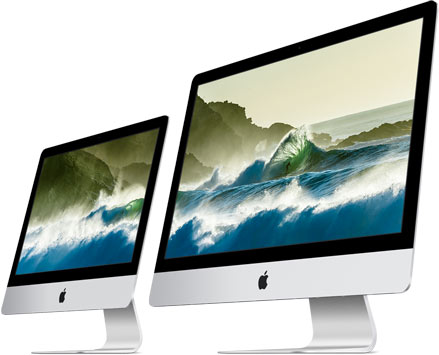External displays for your Mac: how high can you go, how many can you have.
Ultra HD, 4K, 5K, are already becoming the new standard in home entertainment. Most of the latest smart TV sets available to consumers have left 780p and 1080p resolutions in a trail of dust, in favor of Ultra HD displays and above.

In regard to computers, Apple’s Retina display has been an early pioneer, at least in the concept of multiplying the number of pixels to render a sharper image, which in Apple’s case, does not apply to actual pixel resolution.
With the iMac Retina 5K, and subsequently its 4K entry-level option, Apple has officially let consumers know that the bar on computer display resolutions has been raised, and the options for PC and Mac users looking to expand their desktop real estate, are multiplying.
Up until a couple of years ago, the typical resolution for most higher-end laptops and PCs, was in the 1080p range, or 1920 x 1080. That scenario has changed drastically, with laptops and desktop devices often reaching twice or more the number of pixels. As mentioned earlier, in references to notable examples like the Apple iMac Retina 5K, it seems that there is no longer a limit to the amount of pixels current and future hardware can push on a screen.
Connectors
The standards supporting UHD, 4K, 5K and above, include USB Type-C, DisplayPort, Thunderbolt and HDMI, among the most common, however, the connector is only the end-point that carries the source of the signal. By that token, we can’t assume that every device on the market today has the capability to extend its desktop real estate to multiple 4K or 5K displays. With reference to Apple Mac computers, the list of devices supporting the highest resolutions available, is rather extensive, and most Macs built after 2013, and a small number built as far back as 2011.
Frequency
While the above mentioned are compatible and capable of transmitting video signal to 4K and 5K monitors, the experience varies considerably, depending on the hardware involved, specifically as far as refresh rate, which is measured in Hertz, and falls, most frequently within the 25Hz, 30Hz and 60Hz frequency range.
UHD, 4K and 5K displays are capable of a refresh rate up to 60Hz, however the hardware from which the video source originates, must be able to provide adequate input as well. This means that if a computer is only capable of handling 24Hz, or 30Hz, no matter what display is being used, the end result will not offer a refresh rate any higher.
This implicates that running a 4K display at a refresh rate of 24Hz or 30Hz, will result in a very choppy, flickered experience, causing mouse pointer lag, frustratingly slow responsiveness from apps and the operating system, as well as very poor performance when playing games or watching videos. When it comes to 4K or 5K resolutions, hardware capable of running a display signal up to 60Hz is almost mandatory for an acceptable experience.
Fortunately, as mentioned above, most Macs manufactured after 2013, are fitted with a Thunderbolt 2 connector. The list includes:
- All MacBook Pro Retina laptops built since the last quarter of 2013,
- the Mac Pro,
- the late 2014 Mac Mini,
- the early 2015 MacBook Air,
- the 12 inch MacBook Retina,
- and at the cost of stating the obvious, all iMac Retina, built since Fall 2014.
Daisy-chaining
The great thing about Thunderbolt 2, is the ability to “daisy-chain” multiple 4K displays, together, with only the first display in the chain, to be the one required to connect directly to a Thunderbolt Mac. The number of supported displays is set by the capability of the video card. A Mac Pro, for instance, can connect to as many as three 5K displays, and six Thunderbolt displays.
What display does your Mac support?
13 inch MacBook Pro (2015)
Owners of a 2015 13 inch MacBook Pro will have at their disposal two Thunderbolt ports, and is able to connect to two 4K displays at 60Hz.
15 inch MacBook Pro (Mid-2014)
The 15 inch version of the MacBook Pro comes with the choice of an NVIDIA GeForce GT 750M, or AMD Radeon R9 M370X, and supports two 4K displays, or one 5K display at 60Hz.
15 inch MacBook Pro (Late 2013)
The oldest 15 inch version of the MacBook Pro capable of supporting a single 4K display was released in late 2013. Any model prior to this year supports 4K resolution at 30Hz, at best.
MacBook Air (Early 2015)
The latest MacBook Air is the first of its kind to support a single 4K display at 60Hz, using a Thunderbolt connector, thanks to the integrated Intel HD Graphics 6000. All prior MacBook Air laptops lack the ability to drive 4K displays, due to outdated processors and ports.
iMac 21.5 inch Retina 4K and 27 inch Retina 5K (2015)
The latest iMac desktop systems with 4K and 5K Retina displays have the ability to connect to either a single 5K display (27 inch model) using two Thunderbolt cables combined, or two 4K displays (21.4 inch model) at 60Hz.
Mac Pro (Late 2013)
As previously mentioned, owners of the late 2013 refresh of the Mac Pro are able to connect up to three 5K displays, and up to six Thunderbolt displays, however, it has been verified that using an external graphic card, it’s indeed possible to connect as many as six 4K displays.